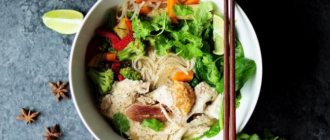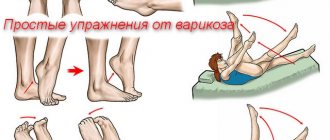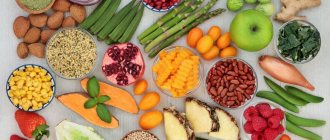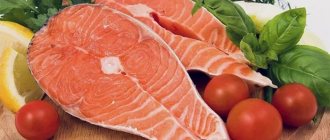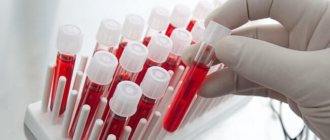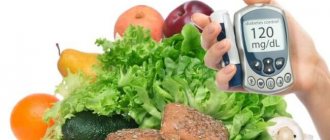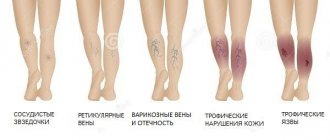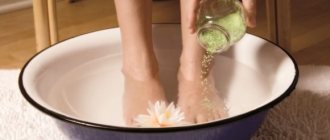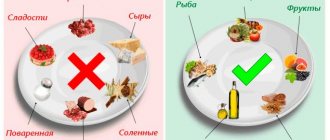The success of treating this insidious disease largely depends on how well the diet is structured for varicose veins in the legs. Even the most modern therapy will be powerless if the rules of food intake are not followed and if there is improper physical activity. To counteract pathological varicose veins, it is necessary to include in your diet as many foods rich in vitamin C and plant fiber as possible. Seafood is also suitable.
The essence and principles of proper nutrition for varicose veins
At the first signs of varicose veins, consult a doctor. He will give recommendations, which may include diet correction. Making some simple changes to your diet can help prevent and treat varicose veins.
The diet for varicose veins is based on the following principles:
- inclusion of fiber in the diet (25–30 g per day);
- drinking enough water;
- reducing salt intake (no more than 6 g per day);
- limiting the consumption of low-fiber foods;
- limiting high-calorie foods that can lead to excess weight gain.
phlebolog.pro
Attention: this information is not a medical recommendation and cannot replace medications, treatment procedures, diagnostics or consultation with a doctor. There may be contraindications. Specialist consultation required!
According to the World Health Organization, in 2001 the number of overweight people in third world countries exceeded the number of hungry people. Since then, the problem of obesity has only gained momentum, acquiring the characteristics of a pandemic. Excess weight entails diseases such as hypertension, diabetes, coronary heart disease and, including varicose veins.
More than 37 thousand different diets have been officially registered, but over the past 20 years, the total excess weight of the world's population has increased 3 times. Diet involves only a temporary change in eating habits, so the concept of diet should be replaced by the concept of proper nutrition.
To date, the influence of two factors related to nutrition and contributing to varicose veins has been proven:
- excess weight
- stool retention (constipation)
A lack of certain vitamins and microelements, as well as an imbalanced protein/fat/carbohydrate ratio, also most likely affects the course of varicose veins. However, it is more difficult to prove this in a strictly scientific way.
In the field of healthy eating, in my opinion, there is now an overabundance of information. Advice is often contradictory, but in order to simply improve your health and save yourself from a lot of problems, you only need to follow a few simple rules. They are very simple, you should not torture yourself with hunger, you just need to give up a number of extremely harmful modern products. For simplicity, I have broken down the nutritional recommendations into 3 levels:
1. If you just want to get rid of excess fat, normalize your weight and, accordingly, save yourself from a lot of problems, just give up sugar and trans fats. These substances have never been found in the human diet; only in recent decades have they truly become the basis of our diet. What is most striking is that they are ridiculously cheap, which is why all dishes in fast foods and other restaurants, as well as ready-made food in supermarkets, are stuffed with them. Avoid sweets, cakes, ice cream, mayonnaise, margarine, and butter. Eat fruits (in moderation), buy unprocessed foods at the market (meat, fish), cook your own food. Eliminate liquid calories - cola, lemonade, kvass, etc. They are very dangerous, you do not feel full. For the same reason, you should not drink freshly squeezed juices; it is better to eat whole fruits.
2. If you want to significantly improve your health, you should give up fast carbohydrates - white rice, any bread and flour products, cereals. Also eliminate saturated fats. Eat only lean meat (chicken breast, turkey), fish, seafood. Many, many people should avoid eating grains and dairy products. Lactose intolerance and celiac disease are well known and less common. However, milk and cereals entered our diet not so long ago and are quite risky products. The connection between their use and health problems can be difficult to trace, but there is evidence that they can contribute to autoimmune diseases, allergies, oncology and many other problems.
3. If you want to significantly improve the quality of your diet, you should pay special attention to the origin of your food. If it is meat, then preferably game or domestic animals raised in the natural environment, on pasture. Be sure to include cold-water sea fish in your diet, preferably wild ones as well. Fruits and vegetables are grown using a variety of fertilizers and are all processed before they hit the shelves, making natural products increasingly difficult to find.
Carbohydrates
You should minimize the consumption of so-called “fast” carbohydrates (with a glycemic index of more than 60): sugar, corn, peanut oil, etc., syrups, beer and other alcohol. These carbohydrates dramatically increase the production of insulin, a transport hormone that promotes fat storage. A sharp change in its concentration in the blood disrupts metabolism. It must be said that there are a lot of such carbohydrate products, most likely it will not be possible to completely eliminate them, so you should limit their quantity, say, consume them only on holidays. Here are other examples of “fast” carbohydrates: bananas, honey, raisins, grapes, sugar, beer, dates, pumpkin, turnips, parsnips, boiled carrots, rye and grain bread, cookies and other baked goods.
It is much healthier to get carbohydrates from buckwheat, rice, oatmeal, pasta made from solid cereals will do.
Fats
Separate mention should be made of fats, because their excess intake from food is the most common nutritional mistake in Russia, Europe and the USA. Fat consumption should be reduced; it should make up no more than 20-30% of the diet (20-25% proteins, 50-60% carbohydrates). In addition, it is necessary to significantly reduce the consumption of saturated fats (lard, butter, whole milk, etc.) and completely eliminate trans fats (margarine, mayonnaise, fast food, etc.). It is advisable to get most of the fats from plant foods; you should also pay attention to foods rich in Omega-3 (red fish, nuts, sesame, flax). You can take additional fats, Omega-3 and Omega-6 preparations only if there is a lack of fat in your diet!
Now let's move on to the recommendations for creating a diet for varicose veins.
#1: Limiting your calorie intake High-calorie diets are associated with an increased risk of varicose veins because they can contribute to the development of obesity and overweight. Many people experience a significant reduction in the symptoms of venous insufficiency after losing just 10% of their body weight. To lose weight, you need to create a calorie deficit. First, you can reduce your calorie intake from food, which will force your body to use up energy reserves such as subcutaneous or visceral fat. Secondly, you can increase your physical activity.
Please note that only overweight and obese people need to lose weight. You must first undergo a medical examination and consult with a nutritionist. There may be contraindications, consultation with a specialist is necessary.
As practice shows, any diet is meaningless if you do not count calories. Without such a diary, a person is not able to control himself, and this is the main reason for the ineffectiveness of any diet. Nowadays it is very convenient to count calories using your smartphone applications: “Calorie Counter” from FatSecret, Calorie Calculator, iWeightBody, Calorie Counter-ShapeUp Club, etc.
You should start by calculating your normal weight. This can be done using special formulas. One of the simplest formulas was proposed by the French surgeon and anthropologist Paul Broca. To calculate normal body weight in kilograms using Broca's formula, subtract 100 from height in centimeters. M = P-100, where M is normal body weight in kg, P is height in cm. Example: your height is 172 centimeters. From 172 we subtract 100 and get 72. This means that your normal weight, according to Brock’s formula, is 72 kilograms.
In recent years, the body mass index
(BMI) .
Weight in kilograms (M) divided by height in meters (P) squared. For example: your height is 1.72 meters, your body weight is 72 kilograms. We square 1.72 m - we get 2.9584 m2. We divide 72 kilograms by 2.9584 m2. After rounding, we get the figure 24.3, which will be your height and weight indicator - it is within the normal range. You have normal body weight. If your body mass index is less than 18.5 kg/m2, then you are underweight; BMI 18.5 - 24.9 - Normal body weight; BMI from 25 to 29.9 - overweight; BMI 30 - 34.9 - class I obesity; 35 - 39.9 - II degree obesity; if your body mass index is more than 40, you have grade III obesity. Weight loss is a key aspect of the anti-varicose veins diet. To lose 0.5 kg per week, you need to create a deficit of approximately 3,500 calories per week. This can be done by reducing your daily calorie intake by 500 calories per day (500 calories x 7 days = 3500 calories). Most nutritionists recommend creating a deficit of 3,500 to 7,000 calories per week for healthy and safe weight loss. Excessive calorie deficit (more than 7,000 calories per week) can impair body functions and even lead to arrhythmias and other acute conditions. In addition, excessive dietary restriction can be counterproductive due to the activation of the body's fat-storing mechanisms. Severe calorie restriction can cause muscle loss and decreased thyroid hormone production, leading to a decrease in metabolic rate and therefore fewer calories burned throughout the day. In addition to limiting calories, it is worth paying attention to the distribution of calorie intake throughout the day. It is usually recommended to eat 5-6 times a day in small portions. This allows you to maintain a more or less constant level of hormones and nutrients in the blood, resulting in reduced cravings for sweets and starches. Breakfast should be the biggest meal of the day. Eating a hearty breakfast kickstarts your metabolism at the proper speed and you will burn more calories throughout the day.
#2: Fiber-rich foods
Fiber is a component of plant foods that is not digested by the body's enzymes. Therefore, fiber is not broken down, is not absorbed into the blood and cannot be used for energy. Dietary fiber can be divided into two main categories: soluble and insoluble. Soluble fiber forms a gel when mixed with water, while insoluble fiber moves through the intestines unchanged. Thanks to its ability to make stools larger and softer, soluble fiber can prevent constipation. Constipation increases pressure on the veins, which over time can contribute to the development of varicose veins. Excellent sources of soluble fiber include oats, flaxseeds, peas, beans, apples, carrots, barley, and berries.
#3: Drink more water
If you eat a lot of fiber-rich foods to avoid constipation, be sure to drink enough water, otherwise the fiber can have the opposite effect and lead to constipation, which in turn can increase the pressure in the veins of the lower extremities. It is also advisable to avoid drinking alcohol, coffee and tea, as these substances dehydrate the body.
You can calculate the required amount using two simple formulas (for men and women):
- Men: Body weight x 35
- Women: Body weight x 31
For example, I weigh 81 kg, which means my daily water requirement is about 2.8 liters.
#4: Eat plenty of foods rich in vitamin C If you have varicose veins, one of the best recommendations is to consume foods rich in vitamins C and E. Vitamin C is essential for the production of collagen and elastin, two important components of connective tissue that help keep veins tight and healthy. elastic. Vitamin C also increases blood circulation. It is therefore not surprising that vitamin C deficiency may be associated with varicose veins. The positive effects of vitamin C on blood vessels are believed to be more pronounced when vitamin C is taken together with vitamin E.
#5: Eat Foods That Contain Bioflavonoids
Bioflavonoids (or simply flavonoids) are a group of compounds found in plants. These compounds give fruits and vegetables their vibrant colors and protect them from germs and insects. There is strong evidence that the properties of bioflavonoids not only protect plants, but also benefit people. Some studies have found a link between high, long-term intake of flavonoids and a reduced risk of developing varicose veins. The beneficial effects of flavonoids are believed to be due to their ability to strengthen the walls of blood vessels and inhibit the action of free radicals within the vessels.
Rutin is one of the flavonoids that has been extensively studied as a potential remedy for varicose veins. Evidence suggests that these powerful bioflavonoids, which are found in abundance in buckwheat, may help relieve swelling and pain associated with varicose veins. Besides buckwheat, there are several other foods that contain rutin in significant quantities.
What foods are useful in treating varicose veins?
Cellulose
- Whole grains (whole grain bread, barley, oatmeal, brown rice).
- Various nuts, seeds.
- Vegetables, legumes (spinach, broccoli, potatoes with skin, carrots, zucchini).
- Fruits and berries (apples, peaches, pears, tangerines, raspberries).
High-fiber foods improve digestion and help prevent constipation, which negatively affects the health of veins and their valves.
Potassium
- Vegetables, legumes (green leafy vegetables, potatoes, white beans, lentils).
- Fruits (oranges, bananas).
- Dried fruits (dried apricots, prunes).
- Nuts (almonds, pistachios).
- Fish (salmon, tuna).
Foods high in potassium can help reduce water retention.
Bioflavonoids
- Vegetables (broccoli, bell pepper, spinach, onion, garlic).
- Fruits and berries (citrus fruits, apples, grapes, cherries, blueberries).
- Cocoa.
Flavonoids improve blood circulation, reduce the risk of blood clots and capillary permeability, and help lower blood pressure.
Vitamins and minerals that should be found in foods
First of all, it is vitamin E. It is a powerful antioxidant that protects cell walls. Products that contain this substance are eggs, oils, as well as lettuce and nuts.
- Vitamin C - helps remove antioxidants, reduce blood viscosity, and strengthen venous walls. These are citrus fruits, cabbage, apples, and unprocessed berries.
- Copper, contained in seafood or seaweed, strengthens the walls of blood vessels, strengthens them, and also participates in the synthesis of elastane, the main component of the vascular wall.
- Silicon, coming from wheat, cereals, legumes, beans and grapes, produces collagen and elastin. In sufficient quantities, it participates in strengthening the vascular wall.
- The fiber contained in the composition stimulates the motility of the gastrointestinal tract and also prevents the formation of constipation.
Example menu for varicose veins
The menu should be balanced and varied and include vegetables, fruits, whole grains, and lean protein. For example, for breakfast you can eat oatmeal with a banana, for lunch - bean soup and salad, and for dinner - boiled chicken breast with vegetable stew. You can snack on nuts, dried fruits or fruits.
Before developing a menu, consult your doctor. A specialist will assess your health and give recommendations on what to eat if you have varicose veins, and what foods are prohibited. Treatment of varicose veins is complex and, in addition to diet correction, may include taking venotonics, surgery and physical therapy.
Colored diet
One of the modern fashion trends in nutrition is the colored diet. It is based on daily changing the diet of plant foods based on their color. The theoretical justification for this diet is that the colors of vegetables and fruits mean the presence of certain beneficial substances necessary for blood vessels. Eating foods of the same color every day is more convenient for the digestive system, which specifically secretes enzymes for the complete absorption of complex substances of the same type.
For example, fruits acquire yellow and orange shades thanks to beta-carotenes - a whole family of pigments and B vitamins. Blue and purple colors are due to the high content of fucoxanthins. Greens rich in chlorophyll are known for their high concentration of micronutrients such as calcium, magnesium, potassium, etc. Red berries, fruits and vegetables contain the most vitamin C.
The effectiveness of the colored diet has been confirmed in practice, due to which it is constantly recommended by many nutritionists as the most rational way to saturate the body with vitamins and minerals of plant origin.
Author of the article:
Kuzmina Vera Valerievna |
Endocrinologist, nutritionist Education: Diploma of the Russian State Medical University named after. N.I. Pirogov, specialty “General Medicine” (2004). Residency at the Moscow State Medical and Dental University, diploma in Endocrinology (2006). Our authors
Fully or partially limited products
Strong meat broths, fatty varieties of red meat, goose meat, duck meat, boiled and smoked sausages, canned meat, bacon, ham, cooking and animal fat, mayonnaise, baked goods, confectionery, as well as heavy cream, cottage cheese, sweets are excluded from the diet. cheesecakes and yogurt, baked milk, fried chicken eggs, salty and fatty cheeses, semolina and oatmeal, pasta, legumes, white rice.
Table salt and salty foods, dishes, spices and seasonings that stimulate the appetite are subject to restrictions.
Limit the consumption of coffee and black tea.
The consumption of smoked meats, marinades, and alcohol-containing drinks is not allowed.
Table of prohibited products
| Proteins, g | Fats, g | Carbohydrates, g | Calories, kcal | |
Cereals and porridges | ||||
| wheat bran | 15,1 | 3,8 | 53,6 | 296 |
Confectionery | ||||
| cake | 3,8 | 22,6 | 47,0 | 397 |
Cakes | ||||
| cake | 4,4 | 23,4 | 45,2 | 407 |
Chocolate | ||||
| chocolate | 5,4 | 35,3 | 56,5 | 544 |
Raw materials and seasonings | ||||
| mayonnaise | 2,4 | 67,0 | 3,9 | 627 |
Dairy | ||||
| milk | 3,2 | 3,6 | 4,8 | 64 |
| cream 35% (fat) | 2,5 | 35,0 | 3,0 | 337 |
| sour cream 30% | 2,4 | 30,0 | 3,1 | 294 |
Cheeses and cottage cheese | ||||
| cheese | 24,1 | 29,5 | 0,3 | 363 |
Meat products | ||||
| fried pork | 11,4 | 49,3 | 0,0 | 489 |
| pork fat | 1,4 | 92,8 | 0,0 | 841 |
| bacon | 23,0 | 45,0 | 0,0 | 500 |
Sausages | ||||
| smoked sausage | 28,2 | 27,5 | 0,0 | 360 |
Bird | ||||
| duck | 16,5 | 61,2 | 0,0 | 346 |
| goose | 16,1 | 33,3 | 0,0 | 364 |
Fish and seafood | ||||
| fried fish | 19,5 | 11,7 | 6,2 | 206 |
Oils and fats | ||||
| cooking fat | 0,0 | 99,7 | 0,0 | 897 |
| rendered pork fat | 0,0 | 99,6 | 0,0 | 896 |
Alcoholic drinks | ||||
| white dessert wine 16% | 0,5 | 0,0 | 16,0 | 153 |
| vodka | 0,0 | 0,0 | 0,1 | 235 |
| cognac | 0,0 | 0,0 | 0,1 | 239 |
| liquor | 0,3 | 1,1 | 17,2 | 242 |
| beer | 0,3 | 0,0 | 4,6 | 42 |
Non-alcoholic drinks | ||||
| cola | 0,0 | 0,0 | 10,4 | 42 |
| coffee | 0,2 | 0,0 | 0,3 | 2 |
| Pepsi | 0,0 | 0,0 | 8,7 | 38 |
| black tea | 20,0 | 5,1 | 6,9 | 152 |
| energy drink | 0,0 | 0,0 | 11,3 | 45 |
| * data is per 100 g of product | ||||
Forbidden food
It is advisable for a person with varicose veins to completely avoid foods such as:
- baked goods;
- salo;
- spicy seasonings;
- walnuts;
- candies;
- cakes, pastries;
- sausages;
- meat and fish of fatty varieties;
- preserves, jams;
- pickles;
- chocolate;
- condensed milk;
- smoked meats;
- ice cream;
- semi-finished products;
- marinades;
- butter;
- bananas;
- canned meat and fish;
- rich broths (including jellied meats, jellies, etc.);
- legumes
Attention: it is necessary to reduce the consumption of foods rich in vitamin K. This substance increases blood clotting, and in large quantities can provoke thrombosis.
“Finding” vitamin K is easy. All green vegetables, as well as herbs and leafy salads, are rich in it. There are many compounds in walnuts, liver, eggs, red meat, and whole milk.
The body needs salt, but in small quantities (about 3-5 g per day). Its excess retains moisture and contributes to the development of swelling.
